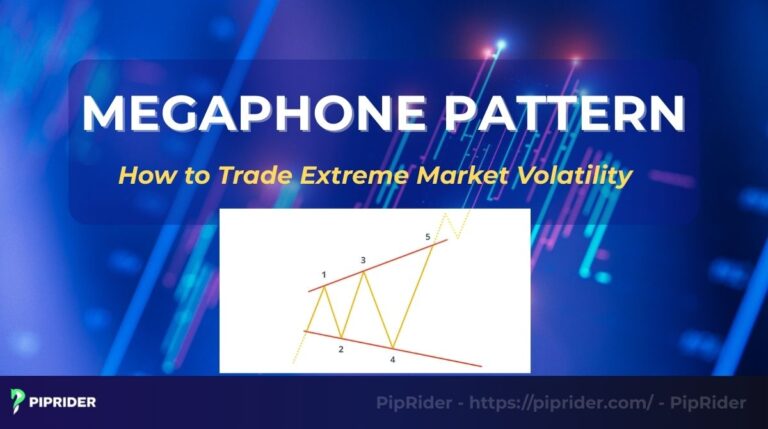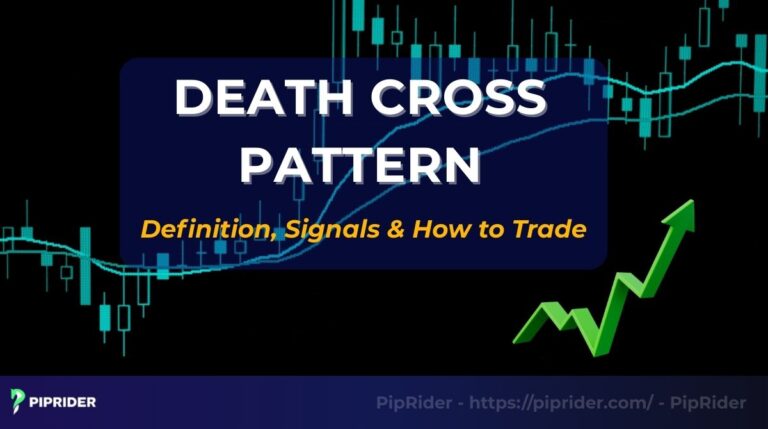Single candlestick patterns are the foundational language of forex trading chart patterns, serving as the building blocks for reading price action. They capture the emotional battle between buyers and sellers within a single trading period, offering clear and immediate insights. Mastering these simple, one-candle formations, such as the hammer and Doji, is crucial for reading market sentiment on candlestick charts.
This guide details 9 powerful single patterns and provides actionable trading strategies for confident price action trading.
Key Takeaways
- Single patterns are the building blocks of analysis, giving instant insights into market sentiment.
- They signal either a potential trend reversal (bullish & bearish reversals, e.g., Hammer) or trend continuations (e.g., Marubozu).
- The pattern’s shape reflects the dominance of either buyers or sellers during the trading period.
- Single patterns are prone to whipsaws. Always confirm the signal using Volume and Multi-Timeframe analysis.
- Each pattern provides an inherent failure point, making it excellent for defining a precise and tight Stop Loss.
1. What Are Single Candlestick Patterns?
Single Candlestick Patterns are formations consisting of one individual candlestick that provides direct insight into market action over a specific timeframe. They display the relationship between the open, high, low, and closing prices.
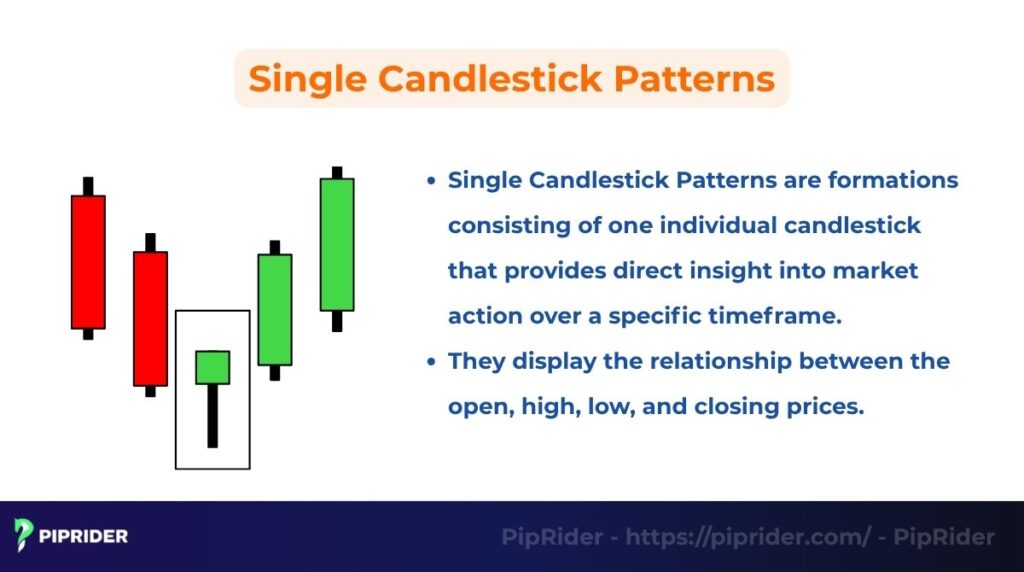
The color and shape of the single candle, specifically the size of its body versus its shadows, tell the story of the market’s internal battle. Understanding these basic building blocks is the starting point for all advanced price action analysis. Single patterns are crucial for technical analysts because they immediately signal shifts in momentum and sentiment. They help traders spot key moments in the trading session.
A single candle can indicate potential trend reversals, strong continuations of the current trend, periods of market indecision, or high volatility. The shape reflects whether buyers (bulls) or sellers (bears) dominated that specific time period. These patterns are often referred to as pin bars.
Single vs. Multi-Candlestick Patterns
The key difference lies in the number of periods required to generate a signal.
- Single Candlestick Patterns derive their signal entirely from one trading period (e.g., one day, one hour). They offer speed and simplicity.
- Multi-Candlestick Patterns (like the Engulfing or Harami) require two or more consecutive candles to complete the formation and confirm the trading signals. They offer higher confirmation but are slower to appear.
2. What Does a Single Candlestick Pattern Indicate?
Interpreting single patterns requires understanding that their significance is never universal; it depends entirely on where and how they appear on the chart. They are immediate visual cues that tell traders three critical pieces of information about the market’s current state.
- Market psychology and momentum: The pattern’s shape directly reflects the battle between bulls and bears. Long wicks signal high conviction but failed attempts. In contrast, a long body signals high conviction and decisive momentum, whereas small bodies (like a Doji) indicate market indecision or a stalemate between supply and demand.
- Trend context and signals: The candle’s meaning relies entirely on its position within the current price trend. A pattern near support/resistance may signal a reversal, whereas one appearing mid-trend (e.g., Marubozu) confirms the current momentum and signals continuation.
- Mandatory confirmation: Due to their simplicity, single candles are prone to false signals. Traders must always confirm the signal’s validity using external tools like high volume and aligning the signal with the dominant multi-timeframe analysis.
Read more:
Cup And Handle Pattern: Definition, Strategies & Target
Triple Top Pattern: Definition, Formation & How to Trade It
3. Most Common Single Candlestick Patterns
While hundreds of candlestick variations exist, only a handful of single patterns deliver consistent, high-probability signals. Recognizing these fundamental structures is essential for successful trading, as they serve as immediate indicators of momentum shifts.
| Pattern | Structure/Shape (Key Feature) | Signal Type | Context (Found At) |
| Hammer | Small body (top), Long lower shadow (2x body). | Bullish Reversal | Swing Lows |
| Shooting Star | Small body (bottom), Long upper shadow (2x body). | Bearish Reversal | Swing Highs |
| Doji | Open ≈ Close (No real body). | Indecision | Trend Exhaustion |
| Spinning Top | Small body, Long equal shadows. | Indecision | Trend Exhaustion |
| Marubozu | Long body, No wicks/shadows. | Strong Continuation | Breakouts/Trends |
| Hanging Man | Hammer shape, but formed at the top. | Bearish Reversal | Market Tops |
| Inverted Hammer | Shooting Star shape, but formed at the bottom. | Bullish Reversal | Market Bottoms |
| Gravestone Doji | Doji at low, Long upper shadow (Inverted T). | Strong Bearish Reversal | Market Tops |
| Belt Hold | Long body, No shadow on opening side. | Strong Continuation | Existing Trends |
3.1. Hammer Candlestick Pattern
The hammer is a single, bullish reversal pattern that typically appears at the swing lows of a downtrend. The Hammer Candlestick Pattern features a small body near the high of the candle and a long lower shadow. The lower shadow must be at least twice the length of the real bodies. This signifies sellers initially pushed the price down, but buyers forcefully brought it back up near the open.
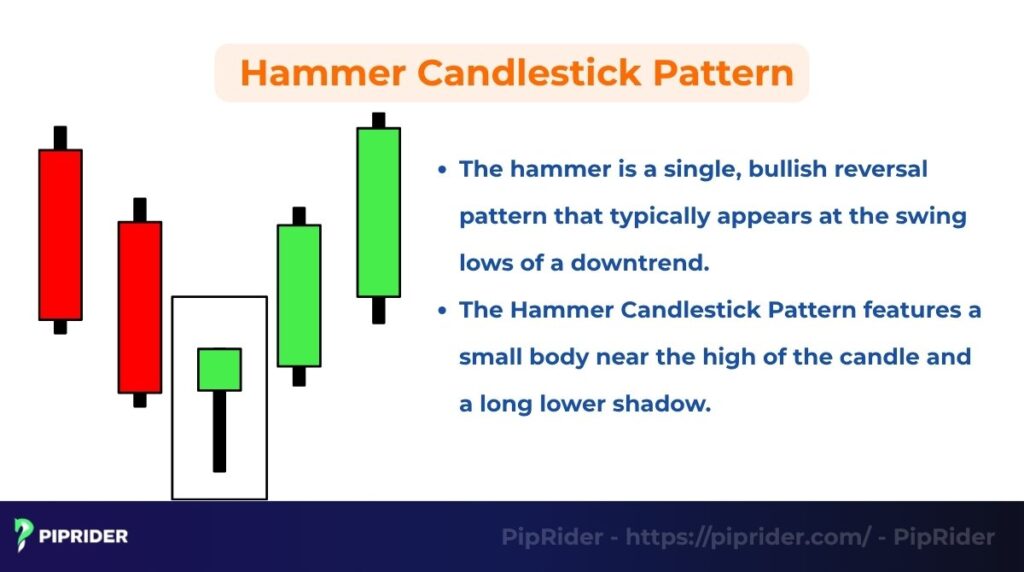
Pros & Cons
- Pros: The Hammer offers a clear, early signal of a potential bullish reversal after a sharp sell-off. The low of the long shadow provides a precise and tight place to put a Stop Loss.
- Cons: Hammer Pattern must be confirmed by a strong bullish move on the next candle and high volume. If it appears during a consolidation or sideways market, it’s often a false signal and should be ignored.
3.2. Shooting Star Candlestick Pattern
The shooting star is a bearish reversal pattern that typically forms at the swing highs of an uptrend or near resistance. It features a small body near the low and a long upper shadow.
The upper shadow must be at least twice the length of the real body. This shows buyers were rejected at the high, as sellers immediately overwhelmed them and forced the price back down before the close.
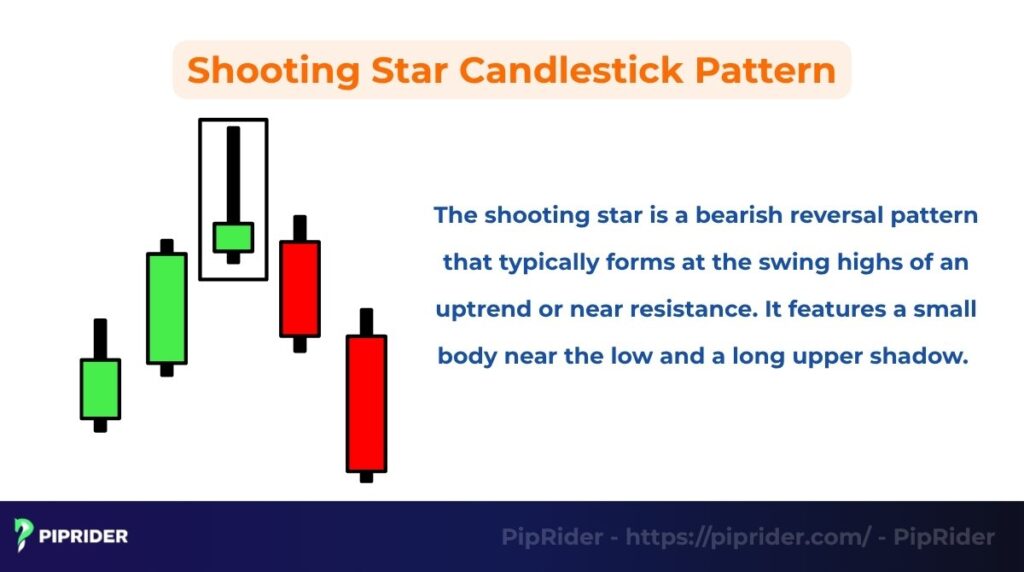
Pros & Cons
- Pros: The Shooting Star Candlestick Pattern provides a strong, early warning signal for a potential bearish reversal. The high of the long shadow offers a tight and precise level for placing a Stop Loss for a short entry.
- Cons: The Shooting Star is only reliable when it follows a clear price advance and is validated by a bearish move on the next candle. It requires high volume confirmation to rule out low-conviction noise.
3.3. Doji Candlestick Pattern
The Doji is identified by having virtually the same opening and closing price, creating a small or non-existent real body. This signifies market indecision; neither buyers nor sellers could gain control during the session.

There are four main variants, each with unique implications:
- Standard: A simple cross shape, showing neutral indecision.
- Long-Legged Doji: Has long wicks, indicating high volatility but a neutral close.
- Dragonfly: Looks like a ‘T’. It is a potential bullish reversal when found at the bottom of a downtrend.
- Gravestone: Looks like an inverted ‘T’. It is a potential bearish reversal when found at the top of an uptrend.
Pros & Cons
- Pros: It is excellent for signaling potential trend exhaustion when it appears after a sustained rally or decline. The unique shapes (Dragonfly/Gravestone) offer highly specific reversal warnings.
- Cons: The Standard Doji has low predictive power on its own and requires strong confirmation from the next candle. When it appears in a choppy, sideways market, it carries no trading significance.
3.4. Spinning Top Candlestick Pattern
The Spinning Top features a small real body centered between an upper and lower shadow of roughly equal length. This narrow range reflects a period of intense trading but ultimately reveals market indecision and uncertainty.
Bulls and bears battled aggressively throughout the trading session, but neither side could sustain control. The close landed very near the open, suggesting a stalemate and potential trend exhaustion.
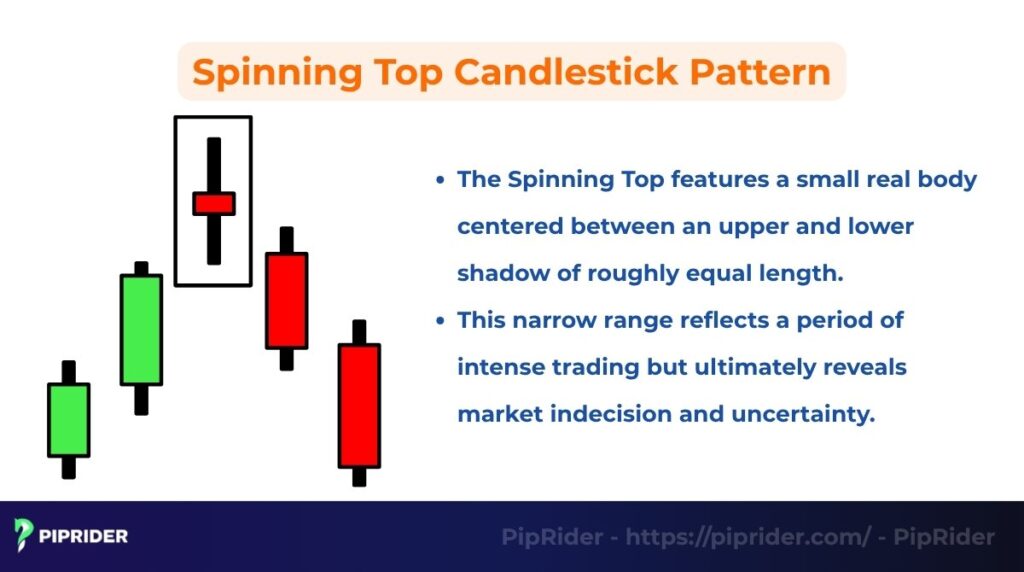
Pros & Cons
- Pros: It serves as a strong preliminary warning of potential trend reversal after a sustained move. It tells traders to pause, tighten stops, and wait for confirmation of the next directional move.
- Cons: Due to its indecisive nature, it has very low predictive power on its own. It holds virtually no significance when appearing in a choppy or sideways market where indecision is already the norm.
3.5. Marubozu Candlestick Pattern
The Marubozu is defined by a long body with virtually no wicks or shadows. This absence of wicks signals absolute dominance by one market force throughout the entire trading period.
- Bullish Marubozu: The price opens at the low and closes at the high. It signals strong trend continuation or a powerful breakout as buyers maintained complete control.
- Bearish Marubozu: The price opens at the high and closes at the low. It signals powerful trend continuation or a decisive breakdown as sellers maintained complete control.
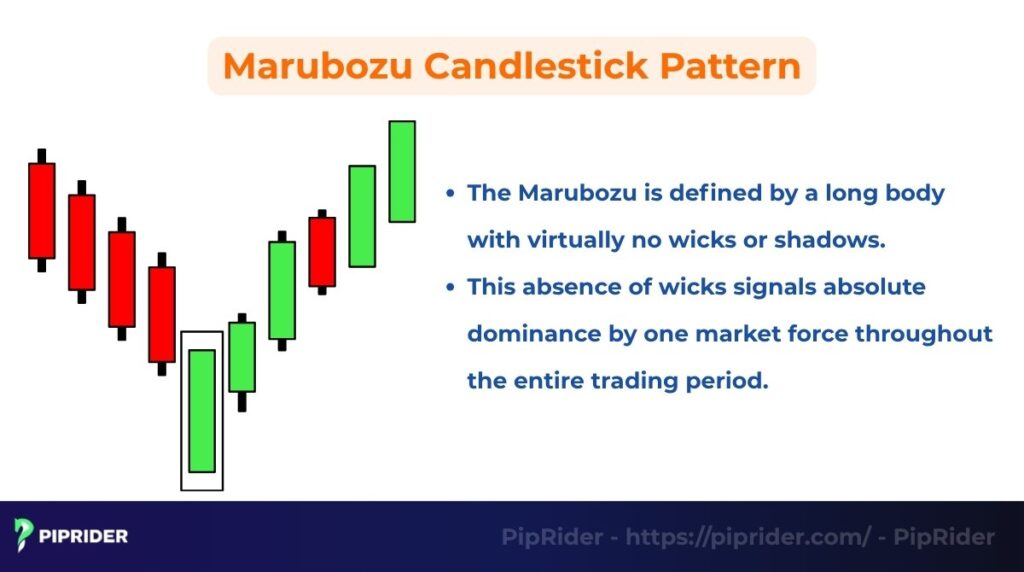
Pros & Cons
- Pros: It provides the clearest, most unambiguous signal of momentum and conviction. Its rigid structure offers a precise and tight level for placing the Stop Loss.
- Cons: It is unreliable without mandatory confirmation from high Volume. Due to its long body, the required Stop Loss distance can sometimes be wide, demanding strict position sizing to manage capital risk.
3.6. Hanging Man Candlestick Pattern
The Hanging Man is a bearish reversal pattern that appears at the top of an uptrend. Structurally, it is identical to the Hammer, featuring a small body near the top and a long lower shadow.
The long lower shadow shows that sellers were able to push the price down significantly during the session. It is only reliable if it appears after a clear advance and is confirmed by a strong bearish candle in the following period, signaling reversal.
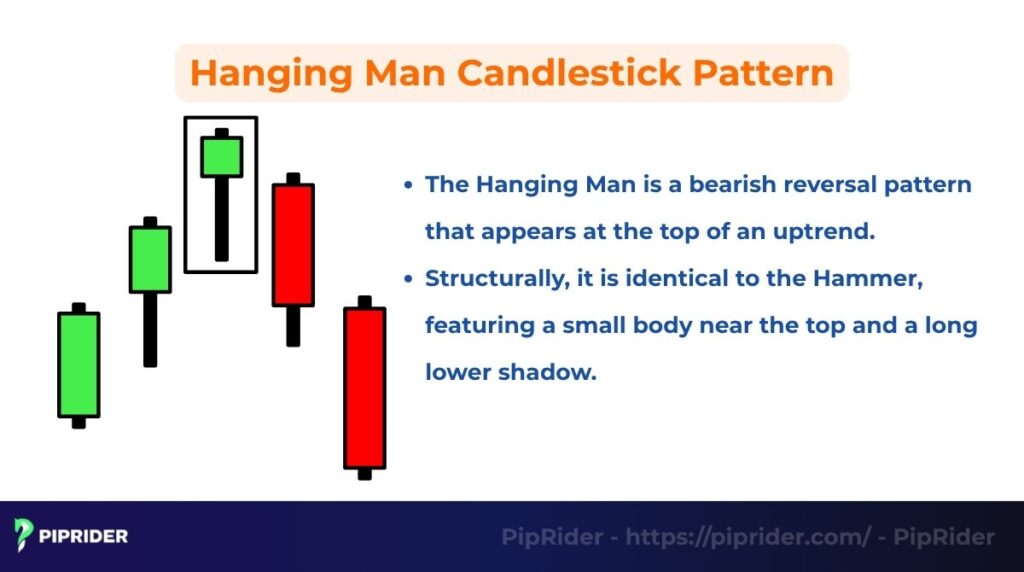
Pros & Cons
- Pros: It provides an early warning signal of seller pressure returning to a mature uptrend, indicating potential trend exhaustion. The low of the candle’s body often serves as a key resistance pivot after the signal. The hanging man requires a confirmed follow-through.
- Cons: Its bearish signal is weak because the candle itself closes higher than its low. It is highly prone to false signals and requires mandatory confirmation from a subsequent price drop and heavy selling volume.
3.7. Inverted Hammer Candlestick Pattern
The inverted hammer is a bullish reversal pattern that appears at the market bottoms of a downtrend. It features a small body near the low and a long upper shadow. It signifies an important shift.
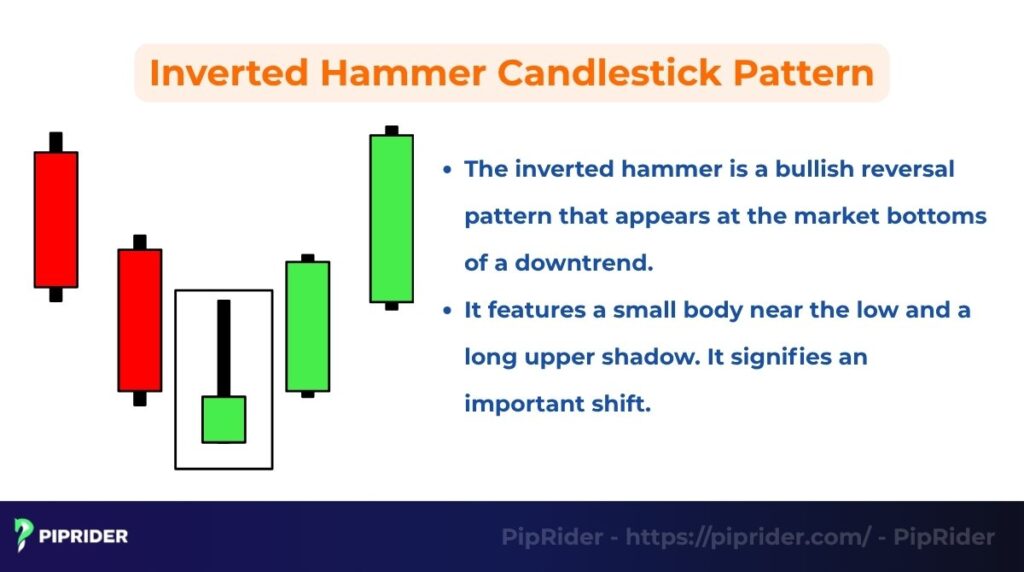
The long upper shadow shows that buyers attempted to push the price higher but were rejected by sellers. However, this appearance after a decline signals a potential shift in momentum and returning buyer aggression.
The effective entry point is confirmed when the subsequent candle closes above the high of the inverted hammer. This signals that the earlier resistance (the high of the shadow) has been successfully overcome.
Pros & Cons
- Pros: The Inverted Hammer Candlestick Pattern offers an excellent early warning of a potential bullish reversal, especially when confirmed by subsequent buying volume. The low of the candle’s body provides a precise location for placing a tight Stop Loss.
- Cons: The Inverted Hammer’s signal is weak and often generates false signals if it is not immediately followed by a strong bullish confirmation candle. Entry must wait until the resistance of the upper shadow is broken.
3.8. Gravestone Doji Pattern
The Gravestone Doji is a specific bearish reversal pattern that typically appears at the market tops of an uptrend. It is structured like an inverted ‘T’, featuring a very small body (open and close are nearly identical) at the low and a long upper shadow.
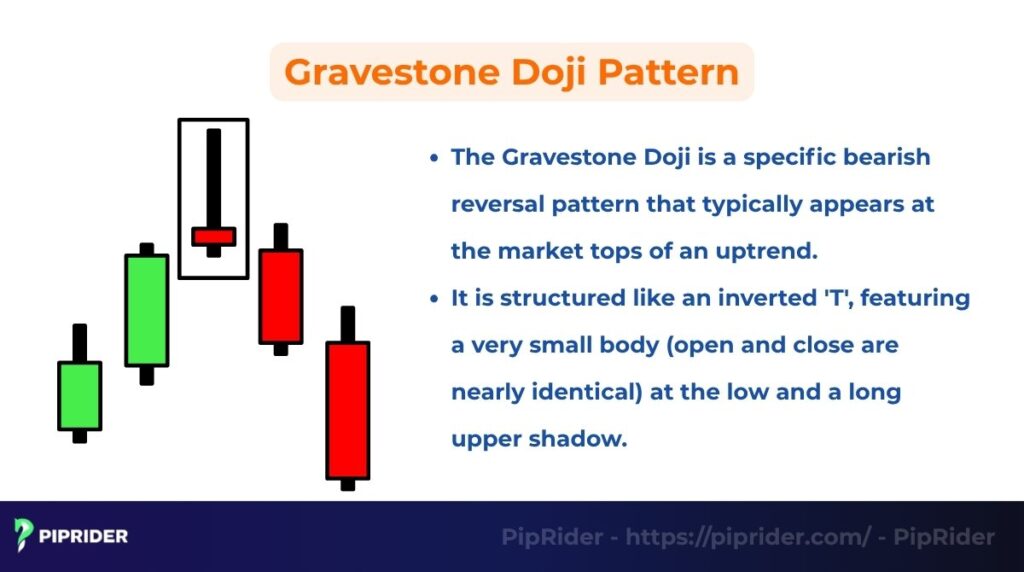
This shows that buyers drove the price up sharply, but sellers ultimately rejected the higher prices and forced the close back down to the open. This strong rejection of the highs is a critical warning of trend exhaustion and a potential reversal.
Pros & Cons
- Pros: It is a highly significant and effective indicator of an imminent bearish reversal when it appears after a prolonged advance. The high of the long shadow provides the absolute best location for placing a tight Stop Loss for a short position.
- Cons: Its significance is zero when found within a downtrend or a sideways market. Confirmation is mandatory; the next candle must close lower than the Doji’s open to validate the reversal signal.
3.9. Belt Hold Candlestick Pattern
The Belt Hold pattern is a trend continuation signal defined by a long body with no shadow on the opening side and a small shadow on the closing side. This shows powerful market commitment from the first trade.
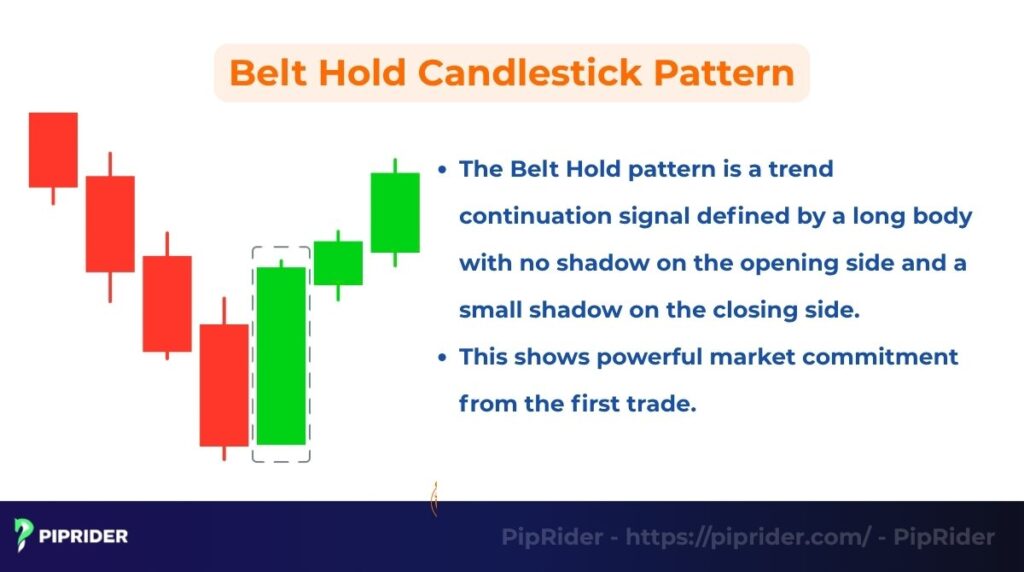
- Bullish Belt Hold: Opens at the absolute low of the period and closes much higher. It confirms the sustained strength of an existing uptrend.
- Bearish Belt Hold: Opens at the absolute high of the period and closes much lower. It confirms the strength of an existing downtrend as sellers maintained control.
Pros & Cons
- Pros: It offers a high-conviction signal of trend continuation due to the clear commitment shown from the very first trade. Its strong body provides an excellent anchor point for defining a tight, precise Stop Loss.
- Cons: It is unreliable if the underlying trend structure is weak or absent. It requires mandatory confirmation from high volume to avoid being a low-conviction, false signal.
Read more:
Evening Star Pattern: A-Z Guide to Spotting Bearish Reversals
4. How to Read a Single Candlestick in Technical Analysis
Interpreting these patterns effectively requires traders to combine the visual signal with broader market context to understand the role of buying and selling pressure in forex trading and filter out low-probability setups. You must evaluate the signal based on three critical contextual layers:
- Analyze position (Trend Context): A single candle’s meaning is irrelevant without trend context. A reversal pattern (like a hammer) is only valid when it appears at a major swing high or swing low; ignore it if it appears mid-trend or in a sideways range.
- Confirm with volume and structure: Confirmation is essential. A signal is significantly more reliable when backed by high volume, which confirms institutional participation. Always check the pattern’s alignment with Market Structure (Support and Resistance) for a high-probability setup.
- Multi-Timeframe confirmation (MTF): Avoid trading against the dominant direction of the market. Use MTF analysis where the higher timeframe defines the main trend, and the lower timeframe is used solely for precise entry timing.
5. How to Trade Using Single Candlestick Patterns
Once you’ve identified and confirmed a high-probability single pattern, the next step is applying precise trade mechanics. Trading success relies not just on spotting the signal but on defining clear, objective rules for entry, stop loss, and profit targets.
5.1. Entry and Exit Strategy
5.1.1. Determining the Entry Point
The primary rule is to wait for confirmation of a single candle signal. For a reversal pattern (like the hammer), enter a trade (buy) only when the subsequent candle closes beyond the high of the signal candle. A bearish pattern (such as the shooting star) requires similar confirmation before taking a short position.
For a continuation candlestick pattern (like a Marubozu), entry can often be taken immediately on the close of the signal candle, provided volume spikes significantly above average to confirm the conviction.
5.1.2. Effective Stop Loss and Take Profit Placement
The structural nature of single patterns provides an inherent point of failure for placing the Stop Loss (SL). Place the SL just outside the tail/shadow of the signal candle (i.e., below the low for a bullish trade or above the high for a bearish trade). The hanging man is a good example.
The Take Profit (TP) target should be the next major Support or Resistance level on the chart. Always ensure the setup maintains a minimum 1:2 Risk-to-Reward (R:R) ratio relative to your tight SL.
5.2. Combining with Indicators
To filter out market traps, single candlestick patterns must be validated by key technical indicators.
- RSI (Relative Strength Index): The RSI confirms reversal patterns by identifying market exhaustion. A bullish signal (e.g., hammer) is stronger if the price is oversold (RSI < 30). A bearish signal gains probability if the price is overbought (RSI > 70). The inverted hammer also benefits from this indicator’s reading.
- Moving Averages (MA): Moving Averages define the overall trend direction and act as dynamic Support/Resistance. A high-conviction signal occurs when a single candle bounces off or breaks cleanly through a key MA (like the 50 or 200-period). The shooting star should occur near resistance.
- MACD (Moving Average Convergence Divergence): The MACD confirms momentum and potential exhaustion. Look for MACD divergence (price and indicator moving in opposite directions) to validate a reversal pattern. A crossover of the MACD lines can also confirm a momentum follow-through.
5.3. Backtesting and Example Chart
Backtesting is the process of applying your trading strategy to historical data to determine its viability and true reliability. Before risking any real capital, you must track the performance of the single candlestick across various market conditions and assets. The shooting star is a prime candidate for testing.
This helps you understand the true failure rate of each pattern, allowing you to optimize your Entry and Stop Loss rules and build confidence in your strategy’s positive Risk-to-Reward (R:R) ratio.
Practical Example: Hammer & Marubozu
Imagine a strong downtrend reaches a major Support level.
- Hammer Signal: A hammer forms precisely at this Support, signaling a potential low. The inverted hammer could also form here.
- Marubozu Confirmation: The very next candle is a Bullish Marubozu that closes high on heavy Volume. This instantly validates the bullish reversal.
Trade Action: Entry is taken at the close of the Marubozu. SL is placed just below the absolute low of the preceding hammer, securing a high-probability trade with tight risk.
6. Importance of Single Candlestick Patterns in Technical Analysis
Single candlestick patterns are essential because they provide immediate, actionable insights that form the basis of effective technical trading strategies.
- Market sentiment Insight: Single candles provide the clearest visual data on the psychological balance between buying and selling pressure. A quick glance reveals if fear (selling) or greed (buying) dominated the trading session.
- Early Trend Reversal Detection: Patterns like the hammer or Doji are often the first warning signs that a trend is exhausting itself. Recognizing these allows traders to position themselves for a reversal earlier than relying on slower, lagging indicators. The hanging man is a key signal.
- Role in trading: These patterns form the core language of price action. They define precise, objective entry and exit points, allowing traders to use the candle’s structure for an accurate, tight Stop Loss and optimizing the Risk-to-Reward (R:R) ratio. The inverted hammer is used for this purpose.
7. Pros and Cons of Single Candlestick Patterns
Single candlestick patterns are invaluable tools, but like any indicator, they come with inherent limitations that traders must manage.
- Advantages (Pros): They are inherently simple and clear to identify, making them ideal for beginners. Their signals are immediate and highly flexible, applying effectively across all assets and timeframes as the core foundation of price action trading.
- Disadvantages (Cons): They are highly prone to market noise and frequently generate head fakes when used in isolation. They mandatorily require supplementary confirmation from high volume and market structure to become a reliable, high-probability trade setup.
8. Frequently asked questions about single candlestick patterns
9. Conclusion
Single Candlestick Patterns are the indispensable foundation of price action, providing immediate visual insight for early reversal and continuation warnings. The hanging man is one such warning.
Success demands strict discipline: Never trade them in isolation. Always confirm signals using Volume and Market Structure before execution. Most importantly, practice stringent risk management by using the pattern’s structure to define a precise, tight Stop Loss.
To continue building your trading patterns knowledge, be sure to follow Piprider. Explore more advanced strategies in our Analysis section.



